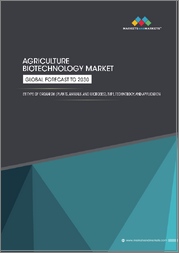
|
시장보고서
상품코드
1697206
세계의 농업 생명공학 시장 조사 보고서 : 산업 분석, 규모, 점유율, 성장, 동향 및 예측(2025-2033년)Global Agricultural Biotechnology Market Research Report- Industry Analysis, Size, Share, Growth, Trends and Forecast 2025 to 2033 |
||||||
세계 농업 생명공학 시장 규모는 2024년 1,764억 3,000만 달러에서 2033년 1,938억 2,000만 달러에 이르고, 2026-2033년의 예측 기간 동안 1.05%의 견조한 연평균 성장률(CAGR)을 보일 것으로 예측됩니다.
농업 생명공학 시장은 세계 인구의 급격한 증가로 인해 지속 가능한 식량 생산이 시급한 상황에서 변혁적 성장의 기로에 서 있습니다. 기후 변화, 토양 황폐화, 물 부족 등의 문제로 인해 혁신적인 생명공학 솔루션은 작물의 수확량과 회복력을 높이는 데 필수적인 요소로 자리 잡고 있습니다. 유전공학, CRISPR 기술 및 기타 첨단 육종 기술을 통해 생산성이 높고 병충해에 강한 작물을 개발할 수 있게 되었습니다. 이러한 생명공학으로의 전환은 전통적인 농법에 혁명을 가져와 보다 효율적이고 환경 친화적인 농법을 만들 수 있을 것으로 기대됩니다.
또한, 농업에서의 생명공학의 통합은 데이터 분석과 생명공학이 융합되어 자원 활용을 최적화하는 정밀 농업의 길을 열어주고 있습니다. 유전자변형작물(GMO)과 바이오포티파이션 작물을 사용함으로써 농부들은 화학비료와 농약 사용을 최소화하면서 더 높은 영양가를 실현할 수 있습니다. 생산성 향상과 환경 부하 감소라는 두 가지 이점이 투자를 유치하고 시장 성장을 가속할 것으로 보입니다. 또한, 식량 안보와 지속가능성에 대한 소비자의 인식이 높아지면서 생명공학 유래 제품에 대한 수요가 증가하고 있어 시장의 미래가 더욱 확실시되고 있습니다.
규제 프레임워크가 바이오테크놀러지의 발전에 대응할 수 있도록 진화함에 따라, 농업용 바이오테크놀러지 시장은 수용과 채택이 증가할 것으로 예측됩니다. 정부, 연구기관, 민간 기업 간의 협력적 노력은 사회적 우려를 해결하고 생명공학 혁신이 안전하게 전개될 수 있도록 하는 데 중요한 역할을 할 것으로 보입니다. 이 시장 전망은 다양한 기후 조건에서 자라고 세계 식량 안보에 기여할 수 있는 작물 개발에 초점을 맞춘 끊임없는 혁신으로 특징지어질 것으로 보입니다. 따라서 농업 생명공학 분야의 이해관계자들은 앞으로 다가올 무수한 기회를 활용할 수 있는 유리한 위치에 있습니다.
당사의 보고서는 고객에게 다양한 산업 및 시장에 대한 종합적이고 실용적인 통찰력을 제공하기 위해 세심하게 작성되었습니다. 각 보고서는 시장 상황을 완전히 이해하기 위해 몇 가지 중요한 요소를 포함하고 있습니다.
시장 개요 : 정의, 분류, 산업 현황 등 시장에 대한 자세한 서론.
시장 역학: 시장 성장에 영향을 미치는 주요 촉진요인, 억제요인, 기회 및 과제를 자세히 분석합니다. 이 섹션에서는 기술 발전, 규제 변화, 새로운 트렌드 등의 요인을 검토합니다.
세분화 분석 : 제품 유형, 용도, 최종 사용자, 지역 등의 기준에 따라 시장을 명확한 부문으로 나눕니다. 이 분석을 통해 각 부문의 성과와 잠재력을 파악할 수 있습니다.
경쟁 구도: 시장 점유율, 제품 포트폴리오, 전략적 이니셔티브, 재무 실적 등 주요 시장 기업들에 대한 종합적인 평가를 제공합니다. 주요 기업들이 채택하고 있는 경쟁 역학 및 주요 전략에 대한 고찰을 제공합니다.
시장 예측 : 실적 데이터와 현재 시장 상황을 바탕으로 일정 기간 동안 시장 규모와 성장 추세를 예측합니다. 여기에는 정량적 분석과 미래 시장 궤적을 나타내는 그래프 표시가 포함됩니다.
지역 분석 : 지역별 시장 성과를 평가하고 주요 시장 및 지역 동향을 파악할 수 있습니다. 지역 시장 역학 및 비즈니스 기회를 이해하는 데 도움이 됩니다.
새로운 트렌드와 기회 : 현재 시장 동향과 새로운 시장 동향, 기술 혁신, 잠재적 투자 대상 분야를 파악합니다. 미래 시장 개척 및 성장 전망에 대한 통찰력을 제공합니다.
목차
제1장 서문
제2장 주요 요약
- 시장 하이라이트
- 세계 시장 현황
제3장 농업 생명공학 업계 분석
- 서론 : 시장 역학
- 시장 성장 촉진요인
- 시장 성장 억제요인
- 기회
- 업계 동향
- Porter의 Five Forces 분석
- 시장의 매력 분석
제4장 밸류체인 분석
- 밸류체인 분석
- 원재료 분석
- 원재료 리스트
- 원재료 제조업체 리스트
- 주요 원재료 가격 동향
- 잠재적 바이어 리스트
- 마케팅 채널
- 직접 마케팅
- 간접 마케팅
- 마케팅 채널 발전 동향
제5장 세계의 농업 생명공학 시장 분석 : 용도별
- 개요 : 용도별
- 실적 데이터와 예측 데이터 분석 : 용도별
- 유전자 재조합 작물(옥수수, 대두, 면화)
- 합성 바이오테크놀러지 제품
- 기술 툴
제6장 세계의 농업 생명공학 시장 분석 : 지역별
- 지역별 전망
- 서론
- 북미의 판매 분석
- 개요, 실적 및 예측
- 북미 : 부문별
- 북미 : 국가별
- 미국
- 캐나다
- 멕시코
- 유럽의 판매 분석
- 개요, 실적 및 예측
- 유럽 : 부문별
- 유럽 : 국가별
- 영국
- 프랑스
- 독일
- 이탈리아
- 러시아
- 기타 유럽
- 아시아태평양의 판매 분석
- 개요, 실적 및 예측
- 아시아태평양 : 부문별
- 아시아태평양 : 국가별
- 중국
- 인도
- 일본
- 한국
- 호주
- 동남아시아
- 기타 아시아태평양
- 라틴아메리카의 판매 분석
- 개요, 실적 및 예측
- 라틴아메리카 : 부문별
- 라틴아메리카 : 국가별
- 브라질
- 아르헨티나
- 페루
- 칠레
- 기타 라틴아메리카
- 중동 및 아프리카의 판매 분석
- 개요, 실적 및 예측
- 중동 및 아프리카 : 부문별
- 중동 및 아프리카 : 국가별
- 사우디아라비아
- 아랍에미리트(UAE)
- 이스라엘
- 남아프리카공화국
- 기타 중동 및 아프리카
제7장 농업 생명공학 기업 경쟁 구도
- 농업 생명공학 시장 경쟁
- 제휴, 협업 및 협정
- 인수합병(M&A)
- 신제품 발매
- 기타 개발
제8장 기업 개요
- 기업 점유율 분석
- 시장 집중도
- Monsanto
- Syngenta
- Bayer CropScience
- Corteva Agriscience
- DuPont Pioneer Hi Bred
- Vilmorin
- Dow AgroSciences
- Evogene Ltd.
- KWS SAAT AG
- Certis USA
- Mycogen Seeds
- ADAMA Agricultural Solutions Ltd.
- Global Bio-chem Technology
- Performance Plants Inc.
- Rubicon
Global Agricultural Biotechnology Market size is anticipated to grow from USD 176.43 Billion in 2024 to USD 193.82 Billion by 2033, showcasing a robust Compound Annual Growth Rate (CAGR) of 1.05% during the forecast period of 2026 to 2033.
The agricultural biotechnology market is on the brink of transformative growth, fueled by the urgent need for sustainable food production in the face of a burgeoning global population. With the challenges posed by climate change, soil degradation, and water scarcity, innovative biotechnological solutions are becoming indispensable for enhancing crop yields and resilience. Genetic engineering, CRISPR technology, and other advanced breeding techniques are enabling the development of crops that are not only more productive but also resistant to pests and diseases. This shift towards biotechnology is expected to revolutionize traditional farming practices, making them more efficient and environmentally friendly.
Furthermore, the integration of biotechnology in agriculture is paving the way for precision farming, where data analytics and biotechnology converge to optimize resource use. By employing genetically modified organisms (GMOs) and biofortified crops, farmers can achieve higher nutritional value while minimizing the use of chemical fertilizers and pesticides. This dual benefit of increased productivity and reduced environmental impact is likely to attract investments and drive market growth. Additionally, the rising consumer awareness regarding food security and sustainability is propelling the demand for biotech-derived products, further solidifying the market's future prospects.
As regulatory frameworks evolve to accommodate biotechnological advancements, the agricultural biotechnology market is expected to witness increased acceptance and adoption. Collaborative efforts between governments, research institutions, and private enterprises will play a crucial role in addressing public concerns and ensuring the safe deployment of biotechnological innovations. The future landscape of this market will be characterized by continuous innovation, with a focus on developing crops that can thrive in diverse climatic conditions and contribute to global food security. As such, stakeholders in the agricultural biotechnology sector are well-positioned to capitalize on the myriad opportunities that lie ahead.
Our reports are meticulously crafted to provide clients with comprehensive and actionable insights into various industries and markets. Each report encompasses several critical components to ensure a thorough understanding of the market landscape:
Market Overview: A detailed introduction to the market, including definitions, classifications, and an overview of the industry's current state.
Market Dynamics: In-depth analysis of key drivers, restraints, opportunities, and challenges influencing market growth. This section examines factors such as technological advancements, regulatory changes, and emerging trends.
Segmentation Analysis: Breakdown of the market into distinct segments based on criteria like product type, application, end-user, and geography. This analysis highlights the performance and potential of each segment.
Competitive Landscape: Comprehensive assessment of major market players, including their market share, product portfolio, strategic initiatives, and financial performance. This section provides insights into the competitive dynamics and key strategies adopted by leading companies.
Market Forecast: Projections of market size and growth trends over a specified period, based on historical data and current market conditions. This includes quantitative analyses and graphical representations to illustrate future market trajectories.
Regional Analysis: Evaluation of market performance across different geographical regions, identifying key markets and regional trends. This helps in understanding regional market dynamics and opportunities.
Emerging Trends and Opportunities: Identification of current and emerging market trends, technological innovations, and potential areas for investment. This section offers insights into future market developments and growth prospects.
SEGMENTATION COVERED IN THE REPORT
By Product Type
- Crop protection products
- Transgenic Seeds
- Synthetic Biology-Enables Products
By Trait Type
- Stacked
- Herbicide-tolerant
- Insect-resistant
- Desirable and Virus-resistant
By Organisms
- Plants
- Animals
- Microbes
By Application
- Vaccine Development
- Transgenic Crops and Animals
- Antibiotic Development
- Nutritional Supplements
- Flower Culturing
- Biofuels
By Technology
- Genome Editing
- Synthetic Biology
- Genetic Engineering
- Marker-assisted Breeding
- Plant Breeding
- Germplasm
- Other Technologies
- COMPANIES PROFILED
- KWS SAAT SE & Co. KGaA
- Dow
- Bayer AG
- BASF SE
- Thermo Fisher Scientific
- Sumitomo Chemical Co. Ltd.
- MITSUI & CO. LTD.
- Novozymes
- Yield10 Bioscience Inc.
- Kemin Industries Inc.
- Valent Biosciences
- Corteva
- DSM
- ADAMA.
- The above list can be customized.
TABLE OF CONTENTS
1 . PREFACE
- 1.1. Report Description
- 1.1.1. Objective
- 1.1.2. Target Audience
- 1.1.3. Unique Selling Proposition (USP) offerings
- 1.2. Research Scope
- 1.3. Research Methodology
- 1.3.1. Market Research Process
- 1.3.2. Market Research Methodology
2 . EXECUTIVE SUMMARY
- 2.1. Highlights of Market
- 2.2. Global Market Snapshot
3 . AGRICULTURAL BIOTECHNOLOGY INDUSTRY ANALYSIS
- 3.1. Introduction - Market Dynamics
- 3.2. Market Drivers
- 3.3. Market Restraints
- 3.4. Opportunities
- 3.5. Industry Trends
- 3.6. Porter's Five Force Analysis
- 3.7. Market Attractiveness Analysis
- 3.7.1 Market Attractiveness Analysis By Application
- 3.7.2 Market Attractiveness Analysis By Region
4 . VALUE CHAIN ANALYSIS
- 4.1. Value Chain Analysis
- 4.2. Raw Material Analysis
- 4.2.1. List of Raw Materials
- 4.2.2. Raw Material Manufactures List
- 4.2.3. Price Trend of Key Raw Materials
- 4.3. List of Potential Buyers
- 4.4. Marketing Channel
- 4.4.1. Direct Marketing
- 4.4.2. Indirect Marketing
- 4.4.3. Marketing Channel Development Trend
5 . GLOBAL AGRICULTURAL BIOTECHNOLOGY MARKET ANALYSIS BY APPLICATION
- 5.1 Overview by Application
- 5.2 Historical and Forecast Data
- 5.3 Analysis by Application
- 5.4 Transgenic Crops (Corn, Soybean, Cotton) Historic and Forecast Sales by Regions
- 5.5 Synthetic Biology-enabled Products Historic and Forecast Sales by Regions
- 5.6 Tools Historic and Forecast Sales by Regions
6 . GLOBAL AGRICULTURAL BIOTECHNOLOGY MARKET ANALYSIS BY GEOGRAPHY
- 6.1. Regional Outlook
- 6.2. Introduction
- 6.3. North America Sales Analysis
- 6.3.1. Overview, Historic and Forecast DataSales Analysis
- 6.3.2. North America By Segment Sales Analysis
- 6.3.3. North America By Country Sales Analysis
- 6.3.4. United State Sales Analysis
- 6.3.5. Canada Sales Analysis
- 6.3.6. Mexico Sales Analysis
- 6.4. Europe Sales Analysis
- 6.4.1. Overview, Historic and Forecast DataSales Analysis
- 6.4.2. Europe by Segment Sales Analysis
- 6.4.3. Europe by Country Sales Analysis
- 6.4.4. United Kingdom Sales Analysis
- 6.4.5. France Sales Analysis
- 6.4.6. Germany Sales Analysis
- 6.4.7. Italy Sales Analysis
- 6.4.8. Russia Sales Analysis
- 6.4.9. Rest Of Europe Sales Analysis
- 6.5. Asia Pacific Sales Analysis
- 6.5.1. Overview, Historic and Forecast DataSales Analysis
- 6.5.2. Asia Pacific by Segment Sales Analysis
- 6.5.3. Asia Pacific by Country Sales Analysis
- 6.5.4. China Sales Analysis
- 6.5.5. India Sales Analysis
- 6.5.6. Japan Sales Analysis
- 6.5.7. South Korea Sales Analysis
- 6.5.8. Australia Sales Analysis
- 6.5.9. South East Asia Sales Analysis
- 6.5.10. Rest Of Asia Pacific Sales Analysis
- 6.6. Latin America Sales Analysis
- 6.6.1. Overview, Historic and Forecast DataSales Analysis
- 6.6.2. Latin America by Segment Sales Analysis
- 6.6.3. Latin America by Country Sales Analysis
- 6.6.4. Brazil Sales Analysis
- 6.6.5. Argentina Sales Analysis
- 6.6.6. Peru Sales Analysis
- 6.6.7. Chile Sales Analysis
- 6.6.8. Rest of Latin America Sales Analysis
- 6.7. Middle East Africa Sales Analysis
- 6.7.1. Overview, Historic and Forecast DataSales Analysis
- 6.7.2. Middle East Africa by Segment Sales Analysis
- 6.7.3. Middle East Africa by Country Sales Analysis
- 6.7.4. Saudi Arabia Sales Analysis
- 6.7.5. UAE Sales Analysis
- 6.7.6. Israel Sales Analysis
- 6.7.7. South Africa Sales Analysis
- 6.7.8. Rest Of Middle East And Africa Sales Analysis
7 . COMPETITIVE LANDSCAPE OF THE AGRICULTURAL BIOTECHNOLOGY COMPANIES
- 7.1. Agricultural Biotechnology Market Competition
- 7.2. Partnership/Collaboration/Agreement
- 7.3. Merger And Acquisitions
- 7.4. New Product Launch
- 7.5. Other Developments
8 . COMPANY PROFILES OF AGRICULTURAL BIOTECHNOLOGY INDUSTRY
- 8.1. Company Share Analysis
- 8.2. Market Concentration Rate
- 8.3. Monsanto
- 8.3.1. Company Overview
- 8.3.2. Company Revenue
- 8.3.3. Products
- 8.3.4. Recent Developments
- 8.4. Syngenta
- 8.4.1. Company Overview
- 8.4.2. Company Revenue
- 8.4.3. Products
- 8.4.4. Recent Developments
- 8.5. Bayer CropScience
- 8.5.1. Company Overview
- 8.5.2. Company Revenue
- 8.5.3. Products
- 8.5.4. Recent Developments
- 8.6. Corteva Agriscience
- 8.6.1. Company Overview
- 8.6.2. Company Revenue
- 8.6.3. Products
- 8.6.4. Recent Developments
- 8.7. DuPont Pioneer Hi Bred
- 8.7.1. Company Overview
- 8.7.2. Company Revenue
- 8.7.3. Products
- 8.7.4. Recent Developments
- 8.8. Vilmorin
- 8.8.1. Company Overview
- 8.8.2. Company Revenue
- 8.8.3. Products
- 8.8.4. Recent Developments
- 8.9. Dow AgroSciences
- 8.9.1. Company Overview
- 8.9.2. Company Revenue
- 8.9.3. Products
- 8.9.4. Recent Developments
- 8.10. Evogene Ltd.
- 8.10.1. Company Overview
- 8.10.2. Company Revenue
- 8.10.3. Products
- 8.10.4. Recent Developments
- 8.11. KWS SAAT AG
- 8.11.1. Company Overview
- 8.11.2. Company Revenue
- 8.11.3. Products
- 8.11.4. Recent Developments
- 8.12. Certis USA
- 8.12.1. Company Overview
- 8.12.2. Company Revenue
- 8.12.3. Products
- 8.12.4. Recent Developments
- 8.13. Mycogen Seeds
- 8.13.1. Company Overview
- 8.13.2. Company Revenue
- 8.13.3. Products
- 8.13.4. Recent Developments
- 8.14. ADAMA Agricultural Solutions Ltd.
- 8.14.1. Company Overview
- 8.14.2. Company Revenue
- 8.14.3. Products
- 8.14.4. Recent Developments
- 8.15. Global Bio-chem Technology
- 8.15.1. Company Overview
- 8.15.2. Company Revenue
- 8.15.3. Products
- 8.15.4. Recent Developments
- 8.16. Performance Plants Inc.
- 8.16.1. Company Overview
- 8.16.2. Company Revenue
- 8.16.3. Products
- 8.16.4. Recent Developments
- 8.17. Rubicon
- 8.17.1. Company Overview
- 8.17.2. Company Revenue
- 8.17.3. Products
- 8.17.4. Recent Developments



















